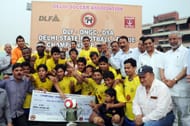Since winning the National Football Championship for the Santosh Trophy in 1944-45, when they beat heavyweights Bengal 2-0 in the final, none of the teams from Delhi have had any major success at the national level. Currently, the game in the National Capital Region has nosedived — football has lost its mass appeal because the entire structure is so unplanned.Why are Delhi clubs not good enough to qualify for the I-League even though the national body, the All India Football Federation (AIFF), is based in the Capital city? What ails the sport in the city?
Solely from the business point of view, the game is not market-oriented in India. There is no return on the investments made in the game. Barring the derbies between Mohun Bagan and East Bengal, none of the I-League matches fetch any returns.
That’s a pan-India picture of the game.
And, Delhi is no exception.
Unplanned schedules, lack of infrastructure, absence of serious grass-root programmes for the kids and a myopic vision have led to the downfall of the game in the Capital.
“Compared to the year-long football activities in Kolkata and Goa, Delhi clubs aren’t too serious to work beyond their three-odd month schedule because most clubs don’t have sound financial support. Hence, the clubs employ players for only three-four months of the year,” said former India captain Prasanta Banerjee, who had coached city’s Tarun Sangha club in 2009.
The Delhi Football League has three tiers – Senior, Division A and Division B. Unlike the leagues in Calcutta and Goa, the tournaments are haphazardly planned and even the clubs usually wake up to sign their players only when the DSA announce the tournament dates. Till then, city’s football activity goes into a sleep mode.
Not surprisingly then, the major corporate houses don’t show much interest in these clubs because they don’t have an identity in Indian football like Bagan and East Bengal.
“The game needs a corporate leader like (former chief of Board of Control for Cricket in India) Jagmohan Dalmiya or (former commissioner of the Indian Premier League) Lalit Modi. We need someone who would have a vision to market the game because the whole structure is so unprofessional,” says Bahadur Singh Mehra of Delhi United, who made their debut in the 2nd Division I-League this year.
The 39-year-old Mehra, an entrepreneur, developed a team that was playing in the A Division in Delhi League five years ago into a top-notch team which gained promotion to the Senior Division League in 2008. In just three years, the club won the Senior Division League title in 2011-12 season.
Money indeed is a big factor and the absence of a strong financial support has triggered the game’s downfall.
However, in 2007 when the I-League kicked-off, corporates began to show interest in Delhi clubs. Art auction house Osians bought New Delhi Heroes in 2007 while Amity took over Nationals a year later. Shastri owners, who incurred losses in their family businesses, decided to sell the club to Delhi-based Infinity Optimal Solution, a sports management company. The takeover of ND Heroes by Osian gave a ray of hope but the honeymoon quickly got over when the company backed out after a year.
“Today, a senior division club needs minimum Rs 15-20 lakh. That’s a huge amount for a Delhi club and there are no investors. Last season, I’ve invested around Rs 54 lakhs on my team solely from my own earnings,” added Mehra.
But Syed Shaheen, secretary of Delhi Soccer Association (DSA), the game’s parent body in the state, and a former player with both Nationals and Moonlight, believes that non-availability of grounds is one of the main reasons why Delhi hasn’t come up strongly.
“In earlier times, the city had Mughals Ground, Government of India Press Ground and many others. There’re no parks and open spaces where one can play football,” complained Shaheen.
Another reason would be decline in patronage shown by some of the prominent schools as most Delhi players came from Anglo-Arabic, PGDAV (Daryaganj) and Raisina (Bengali Market) where football was the top game.
The 317-year-old Anglo Arabic
The inter-school tournaments in the city are too few to attract the youngsters. The Anglo-Arabic School revived the Sherwani Cup after nearly 30 years under a new name in 2009, but it isn’t enough. There are a couple of other tournaments but they have done little to boost the game.
Senior Delhi player Rishi Kapoor, who played two seasons in Mohun Bagan in 2000-01 and 2003-4 and now represents Delhi United, felt that there is a serious lack of interest in Delhi’s football.
Add to it the city youth’s choice of watching the glitzy English Premier League on TV rather than travel to Delhi’s Ambedkar Stadium and follow the meandering state league matches which are often held in Delhi’s torturous heat.
“When I started playing in the mid-90s lot of people used to come and watch our games in Senior Division League. But all that has stopped now because the League is just not attractive,” he explained.
But the parent body’s own poor management skill ensured that the city lost out in the race to traditional pockets like Bengal and Goa.

